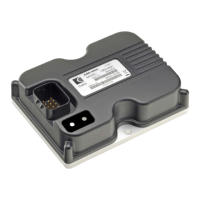Curtis 1352 eXm Manual, R ev. D
33
8 — DIAGNOSTICS & TROUBLESHOOTING
FAULT LOG
The eXm stores the last 16 faults with a time-stamp. The Fault Log is stored
in non-volatile memory with the last fault always at the top of the log and the
oldest fault at the end. If the buffer is full when a new fault occurs, the oldest
fault is pushed of the log, the previous faults all move down, and the newest
fault is placed at the top.
The Fault Log is accessed by SDO reads of the Standard Object at Index
1003h (called the Pre-defined Error Field in DS301). Reading the Fault Log
Length sub-index 00h will return a value of 16 (the depth of the fault log).
Reading from the sub-index 1 though 16 (01h – 10h) will return the faults plus
time stamps in order from newest to oldest.
Faults are stored in the Fault Log as 32-bit data fields in this format:
The first byte is the fault code; see Table 5. The next byte simply indicates a
fault and is consistent with the Emergency Message. If the SDO read of a fault
log sub-index returns a 0 in the fault data, the fault log is clear at that location,
and no fault was recorded.
The time-stamp uses the internal 16-bit running hourmeter. If several
error messages have occurred within one hour, the order of the fault messages
will indicate which came first.
The Fault Log can be cleared by writing 0 to the Fault Log Length object
(sub-index 00h). After clearing, all the data bytes in sub-indexes 01h through
10h will be 0.
Sub-
Name
Index
Index
Description
Fault Log Length 1003h 00h Length of the log (always 16)
Fault 1 01h Newest faultXx
Fault 2 02h Previous fault
Fault 3 03h and so on . . .Xx
Fault 4 04h and so on . . .Xx
.....
Xx
Fault 16 10h Oldest fault.Xx
byte 5 byte 7 & 8byte 6
Fault Time Stamp
FFh
Fault
Code
Hourmeter *
* Note that the MSB of the hourmeter
is in Byte 8.

